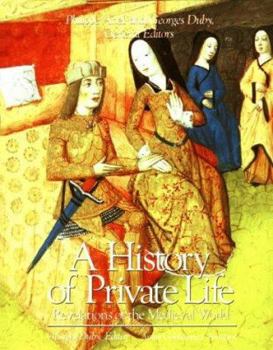A History of Private Life, Volume II, Revelations of the Medieval World: ,
(Book #2 in the A History of Private Life Series)
Select Format
Select Condition 
Book Overview
All the mystery, earthiness and romance of the Middle Ages are captured in this panorama of everyday life. The evolving concepts of intimacy are explored--from the semi-obscure eleventh century through the first stirrings of the Renaissance world in the fifteenth century. Color and black-and-white illustrations.
Format:Hardcover
Language:English
ISBN:0674399765
ISBN13:9780674399761
Release Date:March 1988
Publisher:Belknap Press
Length:650 Pages
Weight:3.27 lbs.
Dimensions:1.7" x 7.2" x 9.4"
Customer Reviews
4 ratings
Intriguing
Published by Thriftbooks.com User , 15 years ago
This is a deep well of information concerning the intriguing subject of privacy. Until modern times, privacy, as we think of it, really didn't exist. Privacy, or lack thereof, was directly influenced by innovation ( architecture, science), economics, health, longevity, marital customs, social structure and mindset. This is essential to understand if you are interested in Medieval and Renaissance history
Moving on to the Middle Ages
Published by Thriftbooks.com User , 20 years ago
This is vol. 2 of the epic, five volume set. Normally, I can see how a reader might shy away from the prospect of reading five volumes on a single subject (any subject). However, given the time span covered and the all encompassing nature of the topic, private life, this is one five volume "history of" set that is worth the time invested. In volume two we move to the late middle ages. Gone is the semi-alien world of Rome, now we are emerging into the more familiar middle ages of western europe. Duby;s introduction discusses the different meaning of "public" and "private" power in the Middle Ages. I'm afraid the discussion was a tad techinical for me on the first read, but the theme seems to be the gradual emergence of the state (as supposed to the family) as the center of power. The second chapter discusses the world of feudal (northern) france and pre-renasissance tuscan italy. Both segments are, to my mind, what this series is all about. I found the section on tuscan italy to overlap nicely with my reading about the Medici family. The differentness between our world and theirs is well apparent. For example, the Tuscan Italians(not that they would call themselves that), kept their unmarried women locked up in their homes. the author repeatedly compares this world to the modern muslim world to give the reader a sense of what he is talking about. The section on "Exploring Literature" is a yawner, up there with the chapter on "Roman Architecure in Africa" from the first book. This book ends with a hint of the modern period which lies ahead, but all in all it is content to dwell in the midevial times and is careful not to jump the gun on the topic of modernity. I appreciated that. Next up, volume three!
very very good read
Published by Thriftbooks.com User , 22 years ago
This is again an extremely full meal as a reading experience, though because of the uniformity of the culture - it does not involve such a fundamental transition as that from paganism to Christianity - it is somewhat less rich than the first volume though equally massive. Nonetheless, there are huge changes going on: at the start of the Gothic era, there was an explosion of availability of materials on private life. Suddenly there were memoires, fiction, more realistic painted portraits (capturing real character and not just stylized), and sturdier surviving architecture, all of which offer a far more accurate picture of the times than was available during the dark ages. Piecing all of this together is utterly fascinating, as the reader is treated to detailed analyses of the costumes, customs, eating habits, and concerns that are reflected in them. You can get a wonderful idea about the texture of everyday life, though more from the standpoint of aristocrats than more common people.Unfortunately, due to the overall goal of the writing on private life, the reasons behind these bigger changes are scarcely mentioned and hence little analyzed. While my disappointment of this reflects my own ignorance of the history of the period, it might also serve as a warning to non-specialists who want to know more. THe only chapter I found dull was a very very long one on the common themes of literary sources.That being said, the book covers written sources, archaeology, and art extremely well: they seem to have been converging on the emergence of the "individual" that occurred just prior to the Renaissance. It is an amazingly interesting story. Indeed, there are so many strands in all of this that I found myself in awe of a period of history that I heretofore saw as far more uniform, as a precursor to the modern era or a disappointing sequel to the astonishing unity and sophistication of the classical era. Recommended.
A Superior History
Published by Thriftbooks.com User , 24 years ago
This book is a superior history of life in the middle ages. Duby's research is exhaustive and all sorts of interesting tidbits about medieval life are scattered through the book. Also there is a profusion of illustrations from the period which help clarify the social history. From castle architecture to peasant clothing, this book covers it all. I highly recommend it for readers interested in the middle ages.






